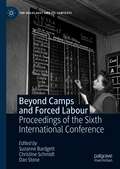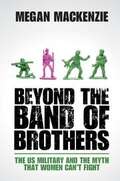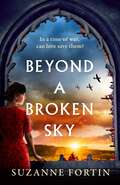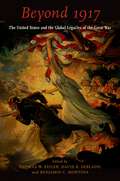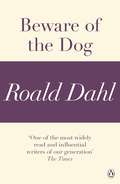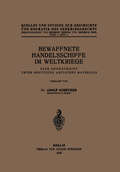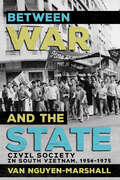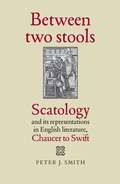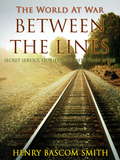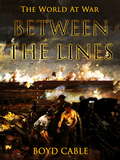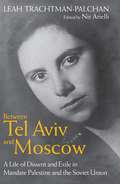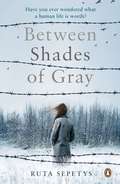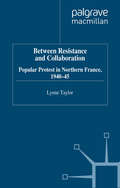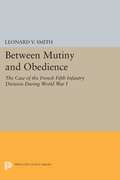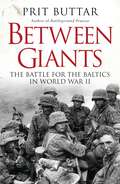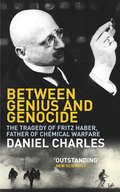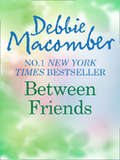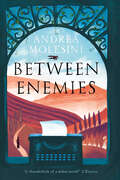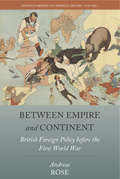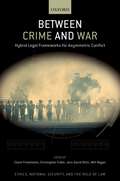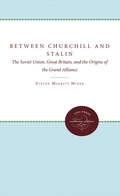- Table View
- List View
Beyond Camps and Forced Labour: Proceedings of the Sixth International Conference (The Holocaust and its Contexts)
by Suzanne Bardgett Christine Schmidt Dan StoneThis book presents a selection of the newest research on themes amplified by the sixth annual Beyond Camps and Forced Labour conference on the post-Holocaust period, including ‘displaced persons’, reception and resettlement, exiles and refugees, trials and justice, reparation and restitution, and memory and testimony. The chapters highlight new, transnational approaches and findings based on underused and newly opened archives, including compensation files of the British government; on historical actors often on the periphery within English-language historiography, including Romanian and Hungarian survivors; and new approaches such as the spatial history of Drancy, as well as geographies that have undergone less scrutiny, for example, Tehran, Chile, Mexico and Cyprus. This volume represents the vibrant and varied state of research on the aftermath of the Holocaust.
Beyond The Band Of Brothers: The Us Military And The Myth That Women Can't Fight (pdf)
by Megan MacKenzieWomen can't fight. This assumption lies at the heart of the combat exclusion, a policy that was fiercely defended as essential to national security, despite evidence that women have been contributing to hostile operations now and throughout history. This book examines the role of women in the US military and the key arguments used to justify the combat exclusion, in the light of the decision to reverse the policy in 2013. Megan MacKenzie considers the historic role of the combat exclusion in shaping American military identity and debunks claims that the recent policy change signals a new era for women in the military. MacKenzie shows how women's exclusion from combat reaffirms male supremacy in the military and sustains a key military myth, the myth of the band of brothers. This book will be welcomed by scholars and students of military studies, gender studies, social and military history, and foreign policy.
Beyond a Broken Sky: In A Time Of War, Can Love Save Them?
by Suzanne FortinSome secrets are better left buried... 2022. Stained-glass expert Rhoda Sullivan is called to Telton Hall to examine a window designed by an Italian prisoner of war during WW2. It should be a quick job but when she and the owner's son, Nate Hartwell, discover a body underneath one of the flagstones in the chapel, Rhoda cannot let the mystery go. She knows what it's like to miss someone who is missing – her twin brother disappeared just before their eighteenth birthday, and she has been looking for him for nearly a decade. But when the threats start, it's clear someone doesn't want the secrets of Telton Hall to come to light.1945. Alice Renshaw is in trouble. Pregnant and alone she is sent away to hide her shame and taken in by Louise Hartwell who has a farm in Somerset worked by prisoners of war. As the weeks pass, Alice finds solace in new friendships, but not everyone at Telton Hall is happy about it. And even though peace has been declared in Europe, the war at home is only just beginning...Perfect for fans of Ellie Midwood, Suzanne Kelman and Suzanne Goldring.Readers love Beyond a Broken Sky! 'Compelling historical mystery... You'll be turning the pages as fast as you can and falling in love with (most of) the characters' Jera's Jamboree, ????? 'Huge fan of this author... An immensely enjoyable novel and highly recommended!' Pickled Thoughts and Pinot, ????? 'Wow, there was a lot going on in this book! A lot of effort has gone into making this story as powerful as it was' Goodreads Reviewer, ????? 'Wonderful book, completely addictive! A fun read and cleverly crafted. Highly recommend' NetGalley Reviewer, ????? 'Suspenseful with an underlying menacing ethos... I enjoyed the female protagonists and the plot twists' Jane Hunt Writer, ????? 'Thoroughly enjoyed this dual timeline book... Another winner from this talented author. Highly recommend' NetGalley Reviewer, ????? 'Beautifully written dual timeline story... Absolutely loved this story. I was captured from the very beginning' NetGalley Reviewer, ????? 'Suzanne Fortin has done it again' Tweedvale Girl Book Reviews, ????? 'Soothing, escapist, and well worth reading... A moving story showcasing that love can conquer all... A very nice mystery' Goodreads Reviewer, ???? 'Very well written book, great plot, moved along fast and kept me engaged... Could easily have read it in one sitting if other things didn't get in the way!' NetGalley Reviewer, ???? 'Heartfelt and moving... Each experience and influence adds together to make something uniquely beautiful' Lotus Writing Therapy, ????Praise for Suzanne Fortin: 'The story brings a warm sense of hope and is moving and joyful in equal measures. A triumph' Celia Anderson 'This story has great depths of emotion, highs and lows, and I found it utterly gripping!' Christina Courtenay 'A deeply moving story of love in all its forms – I adored it' Mandy Baggot 'Five stars' Poppy Alexander
BEYOND 1917 C: The United States and the Global Legacies of the Great War
by Thomas W. Zeiler David K. Ekbladhl; Benjamin C. MontoyaA massively destructive and transformative event, the First World War left in its wake many legacies. Beyond 1917 explores both the consequences of the war for the United States (and the world) and American influence on shaping the legacies of the conflict in the decades after US entry in 1917. From the fields, seas, and airspace of battle, we live today with the consequences of the Great War's poison gas, post-traumatic stress disorder, and technological inventions such as air bombardment of civilians, submarine and tank warfare, and modern surgical techniques. Conscription, pacifism, humanitarian campaigns, and socialist movements emerged from the war to shape politics within countries for decades to come. Governments learned the value of propaganda, both in print and in film. Society changed: women were emancipated in some countries and citizenship was altered in many places, while aristocracy and monarchies went into decline. European empires were transformed and in some cases destroyed; in the Middle East, the change was enormous, beginning with the final collapse of Ottoman hegemony in the region. Fascism and communism, mass migration, independence, militarism, an influenza epidemic, the rise of Wall Street and American economic power, a slowdown in the process of globalization, and the pursuit of world peace by an organization based on collective security numbered among the most significant and lasting legacies of this conflict. Beyond 1917 explores how and why the war has become an integral milepost for human history, reflects the importance of the conflict, the forces that led to it, and the forces it unleashed. On the occasion of the centennial commemorations, an international group of scholars considers the long-term policy, political, social, economic, and cultural consequences of the war for the United States itself and for the world. In addition to interpretive essays, the volume provides a comprehensive bibliography and timeline of events.
Beyond 1917: The United States and the Global Legacies of the Great War
A massively destructive and transformative event, the First World War left in its wake many legacies. Beyond 1917 explores both the consequences of the war for the United States (and the world) and American influence on shaping the legacies of the conflict in the decades after US entry in 1917. From the fields, seas, and airspace of battle, we live today with the consequences of the Great War's poison gas, post-traumatic stress disorder, and technological inventions such as air bombardment of civilians, submarine and tank warfare, and modern surgical techniques. Conscription, pacifism, humanitarian campaigns, and socialist movements emerged from the war to shape politics within countries for decades to come. Governments learned the value of propaganda, both in print and in film. Society changed: women were emancipated in some countries and citizenship was altered in many places, while aristocracy and monarchies went into decline. European empires were transformed and in some cases destroyed; in the Middle East, the change was enormous, beginning with the final collapse of Ottoman hegemony in the region. Fascism and communism, mass migration, independence, militarism, an influenza epidemic, the rise of Wall Street and American economic power, a slowdown in the process of globalization, and the pursuit of world peace by an organization based on collective security numbered among the most significant and lasting legacies of this conflict. Beyond 1917 explores how and why the war has become an integral milepost for human history, reflects the importance of the conflict, the forces that led to it, and the forces it unleashed. On the occasion of the centennial commemorations, an international group of scholars considers the long-term policy, political, social, economic, and cultural consequences of the war for the United States itself and for the world. In addition to interpretive essays, the volume provides a comprehensive bibliography and timeline of events.
Beware of the Dog (A Roald Dahl Short Story)
by Roald DahlBeware of the Dog is a short, gripping story of life in wartime from Roald Dahl, the master of the shocking tale.In Beware of the Dog, Roald Dahl, one of the world's favourite authors, tells of an injured pilot recovering in hospital who makes a disturbing discovery . . .Beware of the Dog is taken from the short story collection Over to You, which includes nine other dramatic and terrifying tales of life as a wartime fighter pilot, and is drawn from Dahl's own experiences during the Second World War.This story is also available as a Penguin digital audio download read by Cillian Murphy.Roald Dahl, the brilliant and worldwide acclaimed author of Charlie and the Chocolate Factory, James and the Giant Peach, Matilda, and many more classics for children, also wrote scores of short stories for adults. These delightfully disturbing tales have often been filmed and were most recently the inspiration for the West End play, Roald Dahl's Twisted Tales by Jeremy Dyson. Roald Dahl's stories continue to make readers shiver today.
Bewaffnete Handelsschiffe im Weltkriege: Eine Denkschrift Unter Benutzung Amtlichen Materials
by Adolf ScheurerDieser Buchtitel ist Teil des Digitalisierungsprojekts Springer Book Archives mit Publikationen, die seit den Anfängen des Verlags von 1842 erschienen sind. Der Verlag stellt mit diesem Archiv Quellen für die historische wie auch die disziplingeschichtliche Forschung zur Verfügung, die jeweils im historischen Kontext betrachtet werden müssen. Dieser Titel erschien in der Zeit vor 1945 und wird daher in seiner zeittypischen politisch-ideologischen Ausrichtung vom Verlag nicht beworben.
Between War and the State: Civil Society in South Vietnam, 1954–1975
by Van Nguyen-MarshallIn Between War and the State, Van Nguyen-Marshall examines an array of voluntary activities, including mutual-help, professional, charitable, community development, student, women's, and rights organizations active in South Vietnam from 1954 to 1975. By bringing focus to the public lives of South Vietnamese people, Between War and the State challenges persistent stereotypes of South Vietnam as a place without society or agency. Such robust associational life underscores how an active civil society survived despite difficulties imposed by the war, government restrictions, economic hardship, and external political forces. These competing political forces, which included the United States, Western aid agencies, and Vietnamese communist agents, created a highly competitive arena wherein the South Vietnamese state did not have a monopoly on persuasive or coercive power. To maintain its influence, the state sometimes needed to accommodate groups and limit its use of violence. Civil society participants in South Vietnam leveraged their social connections, made alliances, appealed to the domestic and international public, and used street protests to voice their concerns, secure their interests, and carry out their activities.
Between two stools: Scatology and its representations in English literature, Chaucer to Swift (PDF)
by Peter J. SmithNow available in paperback, Between two stools investigates the representation of scatology – humorous, carnivalesque, satirical, damning and otherwise – in English literature from the middle ages to the eighteenth century. Smith contends that the ‘two stools’ stand for two broadly distinctive attitudes towards scatology. The first is a carnivalesque, merry, even hearty disposition, typified by the writings of Chaucer and Shakespeare. The second is self-disgust, an attitude characterised by withering misanthropy and hypochondria. Smith demonstrates how the combination of high and low cultures manifests the capacity to run canonical and carnivalesque together so that sanctioned and civilised artefacts and scatological humour frequently co-exist in the works under discussion, evidence of an earlier culture’s aptitude (now lost) to occupy a position between two stools. Of interest to cultural and literary historians, this ground-breaking study testifies to the arrival of scatology as an academic subject, at the same time recognising that it remains if not outside, then at least at the margins of conventional scholarship.
Between two stools: Scatology and its representations in English literature, Chaucer to Swift
by Peter J. SmithNow available in paperback, Between two stools investigates the representation of scatology – humorous, carnivalesque, satirical, damning and otherwise – in English literature from the middle ages to the eighteenth century. Smith contends that the ‘two stools’ stand for two broadly distinctive attitudes towards scatology. The first is a carnivalesque, merry, even hearty disposition, typified by the writings of Chaucer and Shakespeare. The second is self-disgust, an attitude characterised by withering misanthropy and hypochondria. Smith demonstrates how the combination of high and low cultures manifests the capacity to run canonical and carnivalesque together so that sanctioned and civilised artefacts and scatological humour frequently co-exist in the works under discussion, evidence of an earlier culture’s aptitude (now lost) to occupy a position between two stools. Of interest to cultural and literary historians, this ground-breaking study testifies to the arrival of scatology as an academic subject, at the same time recognising that it remains if not outside, then at least at the margins of conventional scholarship.
Between the Lines / Secret Service Stories Told Fifty Years After: Secret Service Stories Told Fifty Years After (The World At War)
by Henry SmithFor those interested in the nitty gritty of the Civil War. It is hard to imagine living at a time and in a place where you were not sure where you and your friends stood. (Excerpt from Goodreads)
Between the Lines (The World At War)
by Boyd CableThis book has been written at the Front within sound of the German guns and for the most part within shell and rifle range It is an attempt to tell something of the manner of struggle that has gone on for months between the lines along the Western Front in WW I.
Between Tel Aviv and Moscow: A Life of Dissent and Exile in Mandate Palestine and the Soviet Union
by Leah Trachtman-PalchanLeah Trachtman-Palchan was an ordinary woman who lived an extraordinary life. This was a life of migration, dissent, exile and survival. Born in the final years of Tsarist Russia, her family was forced to leave their small town following the repeated pogroms of the Civil War era. A two year voyage followed, bringing them all to British Mandate Palestine in 1921. Here what seems like a typical Jewish story of migration from Eastern Europe in the early twentieth century took an unexpected turn. As a teenager, Leah joined the Communist movement in Palestine – illegal under the British Mandate. She was arrested, imprisoned and eventually deported by the British to the Soviet Union. This memoir is filled with colourful, and sometimes harrowing, sketches of the people who passed through her life during the era of Stalin's Great Purges and the evacuation of factories to Siberia during World War II. Shedding new light on both Mandate Palestine and the Jewish experience in Soviet Moscow, this book reveals the remarkable story of a woman living through some of the most pivotal events of twentieth-century history.
Between Shades Of Gray
by Ruta SepetysOne night fifteen-year-old Lina, her mother and young brother are hauled from their home by Soviet guards, thrown into cattle cars and sent away. They are being deported to Siberia. An unimaginable and harrowing journey has begun. Lina doesn't know if she'll ever see her father or her friends again. But she refuses to give up hope.Lina hopes for her family.For her country.For her future.For love - first love, with the boy she barely knows but knows she does not want to lose . . .Will hope keep Lina alive?Set in 1941, Between Shades of Gray is an extraordinary and haunting story based on first-hand family accounts and memories from survivors.
Between Resistance and Collabration: Popular Protest in Northern France 1940-45 (Studies in Modern History)
by L. TaylorBetween Resistance and Collaboration explores the various means by which the local population both protested the hardships brought about by the Nazi occupation of Northern France, often forcing the authorities to do something about them, and evaded the plethora of regulations, political and economic, when the authorities were unable or unwilling to act.
Between Mutiny and Obedience: The Case of the French Fifth Infantry Division during World War I (PDF)
by Leonard V. SmithLiterary and historical conventions have long painted the experience of soldiers during World War I as simple victimization. Leonard Smith, however, argues that a complex dialogue of resistance and negotiation existed between French soldiers and their own commanders. In this case study of wartime military culture, Smith analyzes the experience of the French Fifth Infantry Division in both pitched battle and trench warfare. The division established a distinguished fighting record from 1914 to 1916, yet proved in 1917 the most mutinous division in the entire French army, only to regain its elite reputation in 1918. Drawing on sources from ordinary soldiers to well-known commanders such as General Charles Mangin, the author explains how the mutinies of 1917 became an explicit manifestation of an implicit struggle that took place within the French army over the whole course of the war.Smith pays particular attention to the pivotal role of noncommissioned and junior officers, who both exercised command authority and shared the physical perils of men in the lower ranks. He shows that "soldiers," broadly defined, learned to determine rules of how they would and would not fight the war, and imposed these rules on the command structure itself. By altering the parameters of command authority in accordance with their own perceived interests, soldiers and commanders negotiated a behavioral space between mutiny and obedience.Originally published in 1994.The Princeton Legacy Library uses the latest print-on-demand technology to again make available previously out-of-print books from the distinguished backlist of Princeton University Press. These editions preserve the original texts of these important books while presenting them in durable paperback and hardcover editions. The goal of the Princeton Legacy Library is to vastly increase access to the rich scholarly heritage found in the thousands of books published by Princeton University Press since its founding in 1905.
Between Giants: The Battle for the Baltics in World War II (General Military Ser.)
by Prit ButtarDuring World War II, Latvia, Lithuania and Estonia found themselves trapped between the giants of the Soviet Union and Nazi Germany. Over the course of the war these states were repeatedly occupied by different forces, and local government organizations and individuals were forced to choose between supporting the occupying forces or forming partisan units to resist their occupation. Devastated during the German invasion, these states then became the site of some of the most vicious fighting during the Soviet counter-attack and push towards Berlin. Many would be caught up in the bitter fighting in the region and, in particular, in the huge battles for the Courland Bridgehead during Operation Bagration, when hundreds of thousands of soldiers would fight and die in the last year of the war. By the end of the war, death and deportation had cost the Baltic States over 20 per cent of their total population and Soviet occupation was to see the iron curtain descend on the region for four decades. Using numerous first-hand accounts and detailed archival research, Prit Buttar weaves a magisterial account of the bitter fighting on the Eastern Front and the three small states whose fates were determined by the fortunes and misfortunes of war.
Between Giants: The Battle for the Baltics in World War II
by Prit ButtarDuring World War II, Latvia, Lithuania and Estonia found themselves trapped between the giants of the Soviet Union and Nazi Germany. Over the course of the war these states were repeatedly occupied by different forces, and local government organizations and individuals were forced to choose between supporting the occupying forces or forming partisan units to resist their occupation. Devastated during the German invasion, these states then became the site of some of the most vicious fighting during the Soviet counter-attack and push towards Berlin. Many would be caught up in the bitter fighting in the region and, in particular, in the huge battles for the Courland Bridgehead during Operation Bagration, when hundreds of thousands of soldiers would fight and die in the last year of the war. By the end of the war, death and deportation had cost the Baltic States over 20 per cent of their total population and Soviet occupation was to see the iron curtain descend on the region for four decades. Using numerous first-hand accounts and detailed archival research, Prit Buttar weaves a magisterial account of the bitter fighting on the Eastern Front and the three small states whose fates were determined by the fortunes and misfortunes of war.
Between Genius And Genocide: The Tragedy of Fritz Haber, Father of Chemical Warfare
by Daniel CharlesIn January 1934, as Hitler's shadow began to fall across Europe, a short, bald man carrying a German passport arrived at the Hotel Euler in Basle. He seemed haunted and restless, as though he urgently needed to be elsewhere. Fritz Haber, Nobel laureate in chemistry, confidante of Albert Einstein and German war hero, had arrived in Basle a broken man and, three days later, he died leaving an uncertain legacy. For some, the great German chemist was a benefactor of humanity, winner of a Nobel prize for inventing a way to nourish farmers' fields with nitrogen captured from the air. For others, he was a war criminal who personally supervised the unleashing of chlorine clouds against British, French and Canadian troops in World War I. Tragedy marked his life. A week after the first gas attack in 1915, Haber's wife took his pistol and shot herself. And in 1933, when Hitler came to power, 'the Jew Haber' was among the first scientists driven out of Germany. Within a year, Haber was dead - denied honour both in his homeland and abroad. No life reveals the moral paradox of science - its capacity to create and destroy - more clearly than Fritz Haber's. Between Genius and Genocide is a story filled with ambition, patriotism, hubris and tragedy, set amidst huge technological advances, arms races, mounting imperialism and war.
Between Friends: White Lace And Promises Friends - And Then Some (Mills And Boon M&b Ser.)
by Debbie MacomberPerfect for fans of Maeve Binchy' - Candis Jillian Lawton and Lesley Adamski. Two girls from very different backgrounds.
Between Enemies
by Andrea MolesiniNovember 1917. When Austrian forces advance into Northern Italy, the aristocratic Spada family find their estate requisitioned by enemy soldiers. A cruel act of violence against a group of local village girls sparks their desire for revenge. The whole family - from the eccentric grandparents to the secretive servants - have their own ideas about how to fight the enemy, but their courage is soon put to the test and it seems that some are willing to compromise. Seventeen-year-old Paolo Spada, the youngest member of the family, is forced to bear witness as his once proud family succumbs to acts of love and hate, jealousy and betrayal.
Between Empire and Continent: British Foreign Policy before the First World War (Studies in British and Imperial History #5)
by Andreas RosePrior to World War I, Britain was at the center of global relations, utilizing tactics of diplomacy as it broke through the old alliances of European states. Historians have regularly interpreted these efforts as a reaction to the aggressive foreign policy of the German Empire. However, as Between Empire and Continent demonstrates, British foreign policy was in fact driven by a nexus of intra-British, continental and imperial motivations. Recreating the often heated public sphere of London at the turn of the twentieth century, this groundbreaking study carefully tracks the alliances, conflicts, and political maneuvering from which British foreign and security policy were born.
Between Crime and War: Hybrid Legal Frameworks for Asymmetric Conflict (ETHICS NATIONAL SECURITY RULE LAW SERIES)
by Claire Finkelstein, Christopher Fuller, Jens David Ohlin and Mitt ReganThe threat posed by the recent rise of transnational non-state armed groups does not fit easily within either of the two basic paradigms for state responses to violence. The civilian paradigm focuses on the interception of demonstrable immediate threats to the safety of others. The military paradigm focuses on threats posed by collective actors who pose a danger to the state's ability to maintain basic social order and, at times, the very existence of the state. While the United States has responded to the threat posed by non-state armed groups by using tools from both paradigms, it has placed substantially more emphasis on the military paradigm than have other states. While several reasons may contribute to this approach, one may be the assumption that a state must use each set of tools strictly according in accordance with the principles that underlie each paradigm. Implicit in this assumption may be the sense that the only alternative to the civilian paradigm is the unqualified military one. The chapters in this book suggest, however that we need not see the options as confined to this binary choice. It may be profitable to consider borrowing elements from each paradigm on some occasions to act more expansively than the conventional civilian paradigm allows, but less expansively than the conventional military paradigm would permit. At the same time, the mixing of the categories comes with its own ethical and legal risks that should be scrutinized.
Between Crime and War: Hybrid Legal Frameworks for Asymmetric Conflict (ETHICS NATIONAL SECURITY RULE LAW SERIES)
The threat posed by the recent rise of transnational non-state armed groups does not fit easily within either of the two basic paradigms for state responses to violence. The civilian paradigm focuses on the interception of demonstrable immediate threats to the safety of others. The military paradigm focuses on threats posed by collective actors who pose a danger to the state's ability to maintain basic social order and, at times, the very existence of the state. While the United States has responded to the threat posed by non-state armed groups by using tools from both paradigms, it has placed substantially more emphasis on the military paradigm than have other states. While several reasons may contribute to this approach, one may be the assumption that a state must use each set of tools strictly according in accordance with the principles that underlie each paradigm. Implicit in this assumption may be the sense that the only alternative to the civilian paradigm is the unqualified military one. The chapters in this book suggest, however that we need not see the options as confined to this binary choice. It may be profitable to consider borrowing elements from each paradigm on some occasions to act more expansively than the conventional civilian paradigm allows, but less expansively than the conventional military paradigm would permit. At the same time, the mixing of the categories comes with its own ethical and legal risks that should be scrutinized.
Between Churchill and Stalin: The Soviet Union, Great Britain, and the Origins of the Grand Alliance
by Steven Merritt MinerIt is well documented that relations between the Allies and the Soviet Union were deteriorating from 1943. This volume examines the causes of this conflict that may, in fact, have started in 1940 with the problems of the Baltic states.Originally published 1988.A UNC Press Enduring Edition -- UNC Press Enduring Editions use the latest in digital technology to make available again books from our distinguished backlist that were previously out of print. These editions are published unaltered from the original, and are presented in affordable paperback formats, bringing readers both historical and cultural value.
